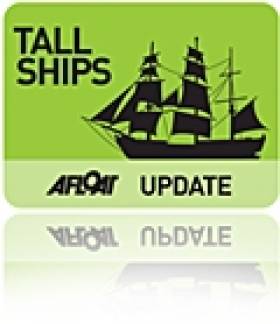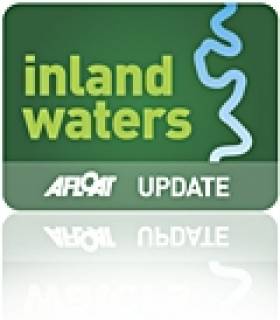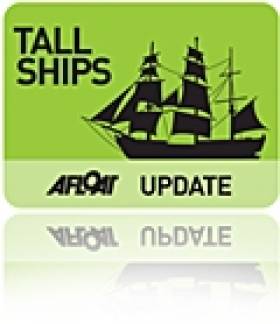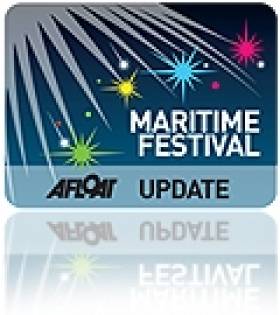Displaying items by tag: Dublin Docklands Development Authority
Dublin’s Tallship Link to Parade of Sails Naval (Guard) Ships
#TALL SHIPS – At the Dublin Tall Ships Races Festival, the docklands-based replica 19th century barque Jeanie Johnston was open to the public, however a former Irish Naval Service vessel, could of been there in her place, had circumstances in the past had taken a different course, writes Jehan Ashmore.
Since 2005, the Jeanie Johnston has been owned by the Dublin Docklands Development Authority (DDDA) which as part of its remit was to regenerate water-borne activity along the Liffey. In May this year it was announced the authority is to be wound-down over a period of 18 months.
The Jeanie Johnston currently serves as a static floating emigrant famine museum. This is a stark contrast to when the barque made a historic re-enactment voyage in 2003 of her predecessor which carried Irish emigrants across the Atlantic, between 1845-1855 to Quebec, Baltimore, and New York.
Prior to the acquisition of Jeanie Johnston by the DDDA, the L.E. Deirdre (P20) was decommissioned four years previously when the Naval Service put her up for auction. She is an elder half-sister of the L.E. Emer (P21) which performed 'guardship' duties during last Sunday's Parade of Sail off Dun Laoghaire Harbour.
Notably the L.E. Deirdre is historically significant in that she was the first custom-built newbuild for the Naval Service and also the first such vessel built in the country, at Verolme Cork Dockyard in 1972, however despite campaigns to keep her as part of our national maritime heritage, this did not materialise, as she was sold at a bargain price of £180,000 to a UK company.
Initially this saw the vessel go to the ship-repair yard of Pomerania, in Szczecin, ironically the Polish city which was the presenting sponsor of the Dublin Tall Ships Races Festival in association with Sail Training International (STI).
However the owner of the former Naval Service vessel, died in 2004, and work on transforming the offshore patrol vessel into a luxury charter yacht, which included installing a helicopter landing pad, came to a standstill. She was sold again and towed to Brazil in 2005 where it is believed the 220ft vessel renamed Santa Rita, painted beige replacing the dull naval grey, was to be completed in 2010.
Yesterday L.E. Emer departed Dublin Port to resume routine patrols and the last large tallship to bid the capital farewell, the A-class, Italian Navy's Amerigo Vespucci, was underway last night. This leaves the Swedish Navy's gaff schooner Falken (class-B) as the last of the tallships still in port.
Future of Graving Docks in Limbo as Plot 8 is Transferred to NAMA
#INLAND WATERWAYS - The site of the former graving docks at Grand Canal Dock has been transferred to NAMA in a deal which frees the Dublin Docklands Development Authority (DDDA) from a €29 million plus bank guarantee.
Plot 8 at Sir John Rogerson's Quay is one of a suite of nine sites that have been transferred to the Government's 'bad bank' in a negotiated loan settlement that extricates the Docklands body from loan guarantees given by banks that financed the "disastrous" Dublin Glass Bottle site deal in 2006.
Sites handed over in the deal include the former 'U2 Tower' and the historic BJ Marine premises on the banks of the Liffey, as well as the aforementioned Dublin Glass Bottle site.
The Dublin branch of the Inland Waterways Association of Ireland (IWAI) had been hoping to embark on a restoration of the graving docks at Plot 8 to their former working order (a detailed history of the docks and restoration plans is available HERE).
This project had been given the blessing of the DDDA and Waterways Ireland, which owns the freehold lease on the site, with a view to its restoration helping to fund the Ulster Canal scheme.
However with the transfer of the DDDA's interest in the site to NAMA, the authority has now withdrawn permission for the IWAI to do any restoration work, leaving the future of the graving docks in limbo.
Jeanie Johnston Visitor Numbers Disappointing But Improving
#TALL SHIPS - Just 17,500 people have visited the replica famine ship Jeanie Johnston since it opened for tours in July 2010, the Sunday Business Post reports.
The disappointing number is around a quarter of those who embarked on Dublin's Viking Splash Tours in 2010.
However, Fáilte Ireland says preliminary figures for 2011 show a 50 per cent rise in visitor numbers at the tall ship over last year, with an average of 1,250 per month compared to 833 monthly in 2010.
The Jeanie Johnston, which is moored off Custom House Quay in the city centre, was purchased by the Dublin Docklands Development Authoruty for €27m in 2005.
Crosbie’s Café Lightship Plan Rejected
Dublin City Council told Crosbie that consent for the use of the campshires for the bar had not been agreed to by the board of the Dublin Dockland Development Authority (DDDA), which owns the quays, "and that said permission will not be forthcoming".
Crosbie had received a letter from the then chief executive officer of the DDDA Paul Maloney in December 2008 saying that the authority was willing to let the development go ahead, subject to consent from the authority's executive board.
This permission will not know be forthcoming but the authority does feel that the ship should be used as a bar on the Liffey itself rather than on the campshires.
The Kittiwake has laid idle since 2007 when the vessel was purchased from the Commissioners of Irish Lights. She was the second last lightship to serve in Irish waters. During the 1980's she and several other lightships were converted from manned operation into automatic light-floats or ALF's. To read more about the last Irish lightship ALF Gannet click HERE.
Largest Vessel Transits Samuel Beckett Swing-Bridge
She remained alongside this berth which is normally used by large commercial ships until the vessel sought a berth much closer to the city-centre. This led to a shift of berths in the evening when the 2003 built vessel headed upriver to the Dublin City Moorings facility at Custom House Quay, but this firstly required transiting through two bridges.
With a beam of 10.6m Fortunate Sun entered through the East-Link toll-lift bridge followed by the Samuel Beckett bridge, the Liffey's newest crossing point which opened in late 2009. The €60m bridge was commissioned by Dublin City Council and designed by the Spanish architect engineer Santiago Calatrava. To read more on the bridge click HERE.
Fortunate Sun is registered in the Caymen Islands and is capable of over 17 knots on a range of 5000 nautical miles. She has a steel hull and an aluminium superstructure and interiors also by Tim Heywood Design. In the early hours of tomorrow morning the vessel built by Oceanfast is to depart through the 5,700 tonnes bridge which was delivered by barge after a five-day voyage from Rotterdam.
There has been previous transits of the bridge notably the annual Dublin Rally organised by the the Inland Waterways Association of Ireland (IWAI). This year's Dublin Rally took place on 1 May when boats travelling on the Royal Canal descended via Croke Park and entered the Liffey at Spencer Dock. This required the Iarnrod Éireann bridge-lift and the water level in Spencer Dock to be lowered so to allow safe clearance under the Sheriff St. bridge.
From there the IWAI flotilla made the short passage downriver to re-enter another inland waterway system at the Grand Canal Dock, marking where the Liffey connects with the city's southern canal. The 2011 Dublin Rally was the first time since 1955 that boats could enter Dublin from the Shannon via the Royal Canal and the first time since 2004 that boats also joined from the Royal Canal.
- powerboats
- motorboats
- inland waterways
- Dublin Port
- Dublin
- Grand Canal
- IWAI
- Royal Canal
- DDDA
- Inland Waterways Association of Ireland
- Dublin City Council
- Spencer Dock
- River Liffey
- Ports and Shipping News
- EastLink Toll Bridge
- Dublin Port news
- Grand Canal Dock
- Dublin Docklands Development Authority
- M.Y. Fortunate Sun
- Tim Heywood Design
- Lifffey
- Dublin City Moorings
- Custom House Dock
- Powerboat news
- Motoryachts
- Sir John Rogerson Quay
- Inland Waterways news
- Dublin Rally
- Ianrod Eireann
- Oceanfast
- Scottish Western Isles
Summer Festival in the Heart of Dublin’s ‘Docklands’
The Docklands Summer Festival takes place this weekend in Dublin's 'Docklands' and it is to host the Waterways Ireland Inter-County Sailing Championship, writes Jehan Ashmore.
Other events taking place on the River Liffey and throughout the docklands range from a Dragon Boat display in the Grand Canal Dock (outer basin) and a Boat Show (inner basin) see map. In addition the Waterways Ireland Visitor Centre will be open, noting all these activities and venues are to take place between 10am-6pm on Saturday.
On the following Sunday the Waterways Ireland Inter-County Sailing Championship Races are scheduled between 10am-4pm in the Grand Canal Dock's outer basin. City Canal Cruises will operate each day as well as an International Food Market, held in the Grand Canal Square, opposite the Grand Canal Theatre.
The pristinely kept M.V. Cill Airne, now a floating restaurant and bar will be open at her berth alongside North Wall Quay, close to the striking Samuel Beckett Bridge and The Convention Centre.
The historic veteran vessel built in Dublin at the Liffey Shipyard in the early 1960's was launched as a passenger tender to serve trans-Atlantic liners that called to Cobh. During her tender-duties she brought the rich and famous ashore to include Laurel & Hardy and US President Eisenhower.
The festival is sponsored by Waterways Ireland and the Docklands Business Forum. To see the full festival programme and a map of the docklands click HERE and www.ddda.ie
- Waterways Ireland
- Cobh
- DDDA
- Dublin Bay News
- Port of Dublin
- River Liffey
- Grand Canal Dock
- Docklands Summer Festival
- Dublin Docklands Development Authority
- Samuel Beckett Bridge
- The Convention Centre
- North Wall Quay
- City Canal Cruises
- Grand Canal Theatre
- M.V.Cill Airne
- Passenger Tender
- TransAtlantic Liners
- Laurel & Hardy
- President Eisenhower
- US President Eisenhower
- Dublin City
- Docklands Business Forum
- Dragon Boat Display
- Dragon's
- Dragon sailing boats
- Dragon craft



































































